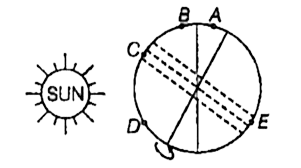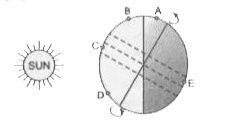If it is noon at one location on Earth, what time is it at a location directly on the other side of Earth?
To solve the question of what time it is at a location directly on the other side of Earth when it is noon at one location, we can follow these steps:
Step 1: Understand the concept of time zones
The Earth is divided into 24 time zones, each representing 15 degrees of longitude. As the Earth rotates, different parts of the world experience day and night at different times.
Step 2: Identify the relationship between time zones
Each time zone represents a one-hour difference. Locations to the west of a given point are one hour earlier, while locations to the east are one hour later.
Step 3: Determine the time difference for locations on opposite sides of the Earth
If it is noon (12:00 PM) at one location, the location directly opposite (on the other side of the Earth) will be 12 hours different in time. This is because the Earth is a sphere, and the opposite side is essentially halfway around the globe.
Step 4: Calculate the time at the opposite location
Since noon is 12:00 PM, subtracting 12 hours gives us:
- 12:00 PM - 12 hours = 12:00 AM (midnight).
Conclusion
Therefore, if it is noon at one location on Earth, it is midnight at the location directly on the other side of the Earth.
---
The Earth is divided into 24 time zones, each representing 15 degrees of longitude. As the Earth rotates, different parts of the world experience day and night at different times.
Each time zone represents a one-hour difference. Locations to the west of a given point are one hour earlier, while locations to the east are one hour later.
If it is noon (12:00 PM) at one location, the location directly opposite (on the other side of the Earth) will be 12 hours different in time. This is because the Earth is a sphere, and the opposite side is essentially halfway around the globe.
Since noon is 12:00 PM, subtracting 12 hours gives us:
- 12:00 PM - 12 hours = 12:00 AM (midnight).
Therefore, if it is noon at one location on Earth, it is midnight at the location directly on the other side of the Earth.
Similar Questions
Moon effect. Some people believe that the Moon controls their activities. If the Moon moves from being directly on the opposite side of Earth from you to being directly overhead, by what percent does (a) the Moon's gravitational pull on you increase and (b) your weight (as measured on a scale) decrease? Assume that the Earth-Moon (center-to-center) distance is 3.82×108 m and Earth's radius is 6.37×106 m.
View SolutionWhat is the amount of work done in bringing a mass from the surface of Earth on one side to a point diametrically opposite on the other side?
View Solution
Knowledge Check
Pineal gland is located on the dorsal side of
AMidbrainBHindbrianCPonsDForebrainWhy is just one side of the Moon visible from Earth?
AThe Moon does not rotate on its axis as it orbits EarthBThe Moon rotates once in the same amount of time that it orbits.CHalf of the Moon is always unlit by the SunDHalf of the Moon does not reflect lightA passenger train travels east at high speed. One passenger is located at the east side of one car, another is located in the west side of the car. In the train's frame, these two passengers glance up at the same time. In the earth's frame,
AThe glance up simultaneouslyBThe passenger at the east side glances up firstCThe passenger at the west side glances up firstDThe passengers glance sideways
Assertion : A geostationary satellite rotates in a direction from west to east.
Reason : At midnight when the sun is directly below. It pulls on an object in the same direction as the pull of the earth on that object. At noon when the sun is directly above. Its pulls on an object in a direction opposite to the pull of the earth.
View SolutionWhat is time period of a second's pendulum at the centre of the earth?
View SolutionIf it is 12 noon in a city located on 90∘ W longitude, what would be the time in a city located on 105∘ W longitude?
View SolutionThe following diagram shows the position of the Earth on a particular day.
A, B, C, D and E are locations on the Earth. Which location will experience longest hours of daylight?

View SolutionThe following diagram shows the position of the Earth on a particular day. A, B, C, D and E are locations on the Earth. Which location will experience longest hours of daylight?

View Solution
